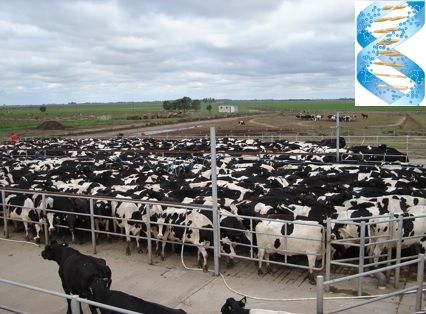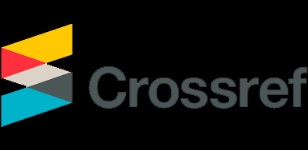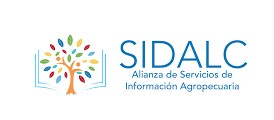Estudio de asociación del polimorfismo del gen de clase II BoLA-DQA1 con resistencia/ susceptibilidad a mastitis en ganado Holstein de la provincia de La Pampa
DOI:
https://doi.org/10.19137/cienvet202224101Palabras clave:
BoLA-DQA1, resistencia, susceptibilidad, mastitis, células somáticasResumen
La mastitis es una enfermedad frecuente en el ganado lechero que conduce a una disminución en la producción y a un incremento en los
costos sanitarios. Esta enfermedad puede evaluarse a través del número de glóbulos blancos por mililitro de leche, conocido como conteo de células somáticas (CCS). La variabilidad alélica de los genes del Complejo Principal de Histocompatibilidad Bovino (Bovine Leukocyte Antigen,
BoLA) se ha asociado con resistencia y susceptibilidad a enfermedades infecciosas. El objetivo del presente trabajo fue estudiar el polimorfismo del gen de clase II BoLA-DQA1 y su asociación con resistencia /susceptibilidad a mastitis medida a través del CCS en leche de ganado Holstein de la provincia de La Pampa. La población se dividió en: 1) grupo caso, con alto CCS y presencia de mastitis (≥ 250.000 cel/ml, susceptible) y 2) grupo control, con bajo CCS (< 250.000 cel/ml, resistente). El BoLADQA1 se genotipo en 60 animales mediante PCR-RFLP y PCR-SBT. El test exacto de Fisher y Odds Ratio (OR) de Woolf-Haldane se utilizaron para estudiar la asociación entre el CCS y las variantes alélicas. Se detectaron 16 alelos del gen BoLA-DQA1 y el alelo BoLA-DQA1*0101 evidenció un OR de 4 (p = 0,058). Se destaca la importancia de los alelos del BoLADQA1 para seleccionar animales resistentes a enfermedades.
Descargas
Citas
Quevedo W. Recuento de células somáticas (rsc), como indicador en la resistencia de la mastitis bovina. Revista Ciencia, Tecnología e Innovación
[Internet]. 2018; Available from: http://www.scielo.org.bo/scielo. php?pid=S2225-87872018000100005&script=sci_arttext
Kerr DE, Wellnitz O. Mammary expression of new genes to combat mastitis. J Anim Sci. 2003; 81 Suppl 3:38–47.
Blum SE, Heller ED, Leitner G. Long term effects of Escherichia coli mastitis. Vet J. 2014
Jul; 201(1):72–7.
Sharif S, Mallard BA, Wilkie BN, Sargeant JM, Scott HM, Dekkers JC, et al. Associations of the bovine major histocompatibility complex DRB3 (BoLA-DRB3) alleles with occurrence of disease and milk somatic cell score in Canadian dairy cattle. Anim Genet. 1998 Jun; 29(3):185–93.
Ariznabarreta A, Gonzalo C, San Primitivo F. Microbiological quality and somatic cell count of ewe milk with special reference to staphylococci. J Dairy Sci. 2002 Jun; 85(6):1370–5.
Park YH, Joo YS, Park JY, Moon JS, Kim SH, Kwon NH, et al. Characterization of lymphocyte subpopulations and major histocompatibility complex haplotypes of mastitis-resistant and susceptible cows. J Vet Sci. 2004 Mar; 5(1):29–39.
Bochantin K, Bewley JM. 0042 The importance of mastitis management practices in maintaining milk quality in the United States. J Anim Sci. 2016; 94(suppl_5):19–20.
Guimarães JLB, Brito MAV, Lange CC, Silva MR, Ribeiro JB, Mendonça LC, et al. Estimate of the economic impact of mastitis: A case study in a Holstein dairy herd under tropical conditions [Internet]. Vol. 142, Preventive Veterinary Medicine. 2017. p. 46–50. Available from: http://dx.doi.org/10.1016/j.prevetmed.2017.04.011
Bedolla CC, de León MP. Pérdidas económicas ocasionadas por la mastitis bovina en la industria lechera. REDVET - Revista Electrónica de Veterinaria. 2008; 9(4):1–26.
Ting JP-Y, Trowsdale J. Genetic control of MHC class II expression. Cell. 2002 Apr; 109 Suppl: S21–33.
Rupp R, Hernandez A, Mallard BA. Association of bovine leukocyte antigen (BoLA) DRB3.2 with immune response, mastitis, and production and type traits in Canadian Holsteins. J Dairy Sci. 2007 Feb;90(2):1029–38.
Brown JH, Jardetzky TS, Gorga JC, Stern LJ, Urban RG, Strominger JL, et al. Three-dimensional structure of the human class II histocompatibility antigen HLA-DR1. Nature. 1993;364:33–9. Available from: http://dx.doi.org/10.1038/364033a0
Tellam RL, Lemay DG, Van Tassell CP, Lewin HA, Worley KC, Elsik CG. Unlocking the bovine genome. BMC Genomics. 2009;10:193. Available from: http://dx.doi. org/10.1186/1471-2164-10-193
Takeshima S-N, Aida Y. Structure, function and disease susceptibility of the bovine major histocompatibility complex. Anim Sci J. 2006 Apr; 77(2):138–50.
Schwab AE, Geary TG, Baillargeon P, Schwab AJ, Fecteau G. Association of BoLA DRB3 and DQA1 alleles susceptible to Neospora caninum and reproductive outcome in Quebec Holstein cattle. Vet Parasitol. 2009 Oct 28; 165(1):136–40.
Baltian LR, Ripoli MV, Sanfilippo S, Takeshima SN, G. G. Association between Bo- LA-DRB3 and somatic cell count in Holstein cattle from Argentina. Mol Biol Rep. 2012 39 (7):7215-7220 Available from: https://link.springer.com/article/10.1007/ s11033-012-1526-y
Baltian LR, Follmer AV, Peratta DL, Schmidt EE, Severini RA, Borrego C, et al. Polimorfismos del exón 2 del gen BoLA-DRB3 asociados con resistencia/susceptibilidad a leucosis en ganado Holstein de La Pampa/Polymorphisms of BoLA-DRB3 gene and its association with resistance/susceptibility to Leukosis in Holstein cattle from La. Ciencia Veterinaria. 2016; 18(1):9–27.
Polat M, Moe HH, Shimogiri T, Moe KK, Takeshima S-N, Aida Y. The molecular epidemiological study of bovine leukemia virus infection in Myanmar cattle. Arch Virol. 2017 Feb; 162(2):425–37.
Miyasaka T, Takeshima SN, Sentsui H, Aida Y. Identification and diversity of bovine major histocompatibility complex class II haplotypes in Japanese Black and Holstein cattle in Japan. J Dairy Sci. 2012;95 (1):420-431 Available from: https://www.sciencedirect. com/science/article/pii/S0022030211007132
EBI Web Services. IPD-MHC Database [Internet]. [cited 2021 May 12]. Available from: https://www.ebi.ac.uk/ipd/mhc/
Glass EJ, Oliver RA, Russell GC. Duplicated DQ haplotypes increase the complexity of restriction element usage in cattle. J Immunol. 2000 Jul 1; 165(1):134–138.
Gelhaus A, Förster B, Wippern C, Horstmann RD. Evidence for an additional cattle DQA locus, BoLA-DQA5. Immunogenetics. 1999 Apr;49(4):321–7.
Russell GC, Gallagher A, Craigmile S, Glass EJ. Characterization of cattle cDNA sequences from two DQA loci. Immunogenetics. 1997;45(6):455–8.
Takeshima S, Aida Y. Polymorphism and disease resistance of bovine major histocompatibility complex. J Animal Gen. 2007;35:51–64. Available from: http://dx.doi. org/10.5924/abgri2000.35.51
Ashwell MS, Heyen DW, Sonstegard TS, Van Tassell CP, Da Y, VanRaden PM, et al. Detection of Quantitative Trait Loci Affecting Milk Production, Health, and Reproductive Traits in Holstein Cattle. J Dairy Sc. 2004;87:468–75. Available from: http://dx.doi. org/10.3168/jds.s0022-0302(04)73186-0
AIDA, Y. Influence of host genetic differences on leukemogenesis induced bovine leukemia virus. AIDS Res Hum Retroviruses. 2001; 17:S12.
Burbano M, Toro R, Montoya F, Ariza F, Tobón JI, Gallego J, et al. Caracterización del locus BoLA-DRB3 en ganado criollo colombiano y asociación con resistencia a enfermedades. Arch Zootec. 2005; 54(206):349–56.
Martinez ML, Machado MA, Nascimento CS, Silva MVGB, Teodoro RL, Furlong J, et al. Association of BoLA-DRB3.2 alleles with tick (Boophilus microplus) resistance in cattle. Genet Mol Res. 2006 Aug 31; 5(3):513–24.
Juliarena MA, Poli M, Sala L, Ceriani C, Gutierrez S, Dolcini G, et al. Association of BLV infection profiles with alleles of the BoLA-DRB3.2 gene. Anim Genet. 2008 Aug; 39(4):432–8.
Panei CJ, Suzuki K, Echeverria MG, Serena MS, Metz GE, Gonzalez ET. Association of Bo- LA-DRB3.2 Alleles with Resistance and Susceptibility to Persistent Lymphocytosis in BLV Infected Cattle in Argentina. Int J Dairy Sci. 2009;4:123–8. Available from: http:// dx.doi.org/10.3923/ijds.2009.123.128
Dietz A B, Detilleux JC, Freeman A E, Kelley D H, Stabel JR, Kehrli M E. Genetic association of bovina lymphocyte antigen DRB3 alleles with immunological traits of Holstein cattle. J Dairy Sci. 1997; (80):400–5.
Kelm SC, Detilleux JC, Freeman AE, Kehrli ME Jr, Dietz AB, Fox LK, et al. Genetic association
between parameters of innate immunity and measures of mastitis in periparturient Holstein cattle. J Dairy Sci. 1997 Aug; 80(8):1767–75.
Zambrano JC., Echeverri JZ., López-Herrera A. Alelos del gen BoLA DRB3.2 están asociados con mastitis en vacas lechera. Rev Colom Cienc Pecu. 2011; 24(2):145–56.
Baltian LR., Rípoli MV., Giovambattista G. Determination of amino acid motifs present in the antigen-binding site of BoLA-DRB3 alleles in a Holstein population of La Pampa y su asociación con mastitis. Ciencia Veterinaria. 2014; 16: 9–27. Available from: http://dx.doi.org/10.19137/cienvet2014-1611
Chu MX, Ye SC, Qiao L, Wang JX, Feng T, Huang DW, et al. Polymorphism of exon 2 of BoLA-DRB3 gene and its relationship with somatic cell score in Beijing Holstein cows. Mol Biol Rep. 2012 Mar;39(3):2909–14.
National Mastitis Council - National Mastitis Council [Internet]. 2016 [cited 2021 May 15]. Available from: http://nmconline.org.
Takeshima S, Miki A, Kado M, Aida Y. Establishment of a sequence-based typing system for BoLA-DQA1 exon 2. Tissue Antigens. 2007 Feb;69(2):189–99.
WebCutter [Internet]. WebCutter. Available from: http://heimanlab.com/cut2.html
EMBL-EBI. The European Bioinformatics Institute < EMBL-EBI [Internet]. [cited 2021 May 14]. Available from: http://www.ebi.ac.uk/
Russell GC, Davies CJ, Andersson L, Mikko S, Ellis SA, Hensen EJ, et al. BoLA class II nucleotide sequences, 1996: report of the ISAG BoLA Nomenclature Committee. Animal Genetics. 1997;28:169–80. Available from: http://dx.doi. org/10.1111/j.1365-2052.1997.00107.x
Daum C, Tighe D, Philip L, Mihalkanin D, Spurrell C, Miller D, et al. The Joining of Competitors:
The Dual Operation of the ABI 3730xl and GE MegaBACE4500 DNA Sequence Analyzers at the DOE Joint Genome Institute. 2006 Feb 6 [cited 2021 May 16]; Available from: https://escholarship.org/uc/item/9hq0x9zp
Nei M. Estimation of average heterozygosity and genetic distance from a small number of individuals. Genetics. 1978 Jul; 89(3):583–90.
Excoffier L, Lischer HEL. Arlequin suite ver 3.5: a new series of programs to perform population genetics analyses under Linux and Windows. Mol Ecol Resour. 2010;10:564– 7. Available from:
http://dx.doi.org/10.1111/j.1755-0998.2010.02847.x
Weir BS, Cockerham CC. ESTIMATING F-STATISTICS FOR THE ANALYSIS OF POPULATION
STRUCTURE. Evolution. 1984 Nov; 38(6):1358–70.
Rousset F. genepop’007: a complete re-implementation of the genepop software for
Windows and Linux. Mol Ecol Resour. 2008 Jan; 8(1):103–6.
Guo SW, Thompson EA. Performing the exact test of Hardy-Weinberg proportion for
multiple alleles. Biometrics. 1992 Jun;48(2):361–72.
Thompson JD, Higgins DG, Gibson TJ. CLUSTAL W: improving the sensitivity of progressive
multiple sequence alignment through sequence weighting, position-specific gap
penalties and weight matrix choice. Nucleic Acids Res. 1994 Nov 11;22(22):4673–80.
Miltiadou D, Law AS, Russell GC. Establishment of a sequence-based typing system for
BoLA-DRB3 exon 2. Tissue Antigens. 2003 Jul;62(1):55–65.
Ripley BD. The R project in statistical computing. MSOR Connections The newsletter
of the LTSN Maths [Internet]. 2001; Available from: https://citeseerx.ist.psu.edu/
viewdoc/download?doi=10.1.1.449.6899&rep=rep1&type=pdf
Miyasaka T, Takeshima S-N, Matsumoto Y, Kobayashi N, Matsuhashi T, Miyazaki Y, et
al. The diversity of bovine MHC class II DRB3 and DQA1 alleles in different herds of
Japanese Black and Holstein cattle in Japan. Gene. 2011 Feb 1;472(1-2):42–9.
Takeshima S, Chen S, Miki M, Kado M, Aida Y. Distribution and origin of bovine major histocompatibility
complex class II DQA1 genes in Japan. Tissue Antigens. 2008;72:195–
Available from: http://dx.doi.org/10.1111/j.1399-0039.2008.01092.x
Kułaj D, Pokorska J, Ormian M, Dusza M. Short Communication: New alleles at the Bo-
LA-DQA1 locus in Holstein–Fresian cattle. Can J Anim Sci. 2015 Jun;95(2):161–4.
Takeshima S-N, Ohno A, Aida Y. Bovine leukemia virus proviral load is more strongly
associated with bovine major histocompatibility complex class II DRB3 polymorphism
than with DQA1 polymorphism in Holstein. Retrovirology, 2019; 16 (1):
p. 1-6. Available from: https://retrovirology.biomedcentral.com/articles/10.1186/
s12977-019-0476-z

Publicado
Número
Sección
Licencia
Al momento de enviar sus contribuciones, los colaboradores deberán declarar , de manera fehaciente, que poseen el permiso del archivo o repositorio donde se obtuvieron los documentos que se anexan al trabajo, cualquiera sea su formato (manuscritos inéditos, imágenes, archivos audiovisuales, etc.), permiso que los autoriza a publicarlos y reproducirlos, liberando a la revista y sus editores de toda responsabilidad o reclamo de terceros , los autores deben adherir a la licencia Creative Commons denominada “Atribución - No Comercial CC BY-NC-SA”, mediante la cual el autor permite copiar, reproducir, distribuir, comunicar públicamente la obra y generar obras derivadas, siempre y cuando se cite y reconozca al autor original. No se permite, sin embargo, utilizar la obra con fines comerciales.







.jpg)

4.png)


7.png)






